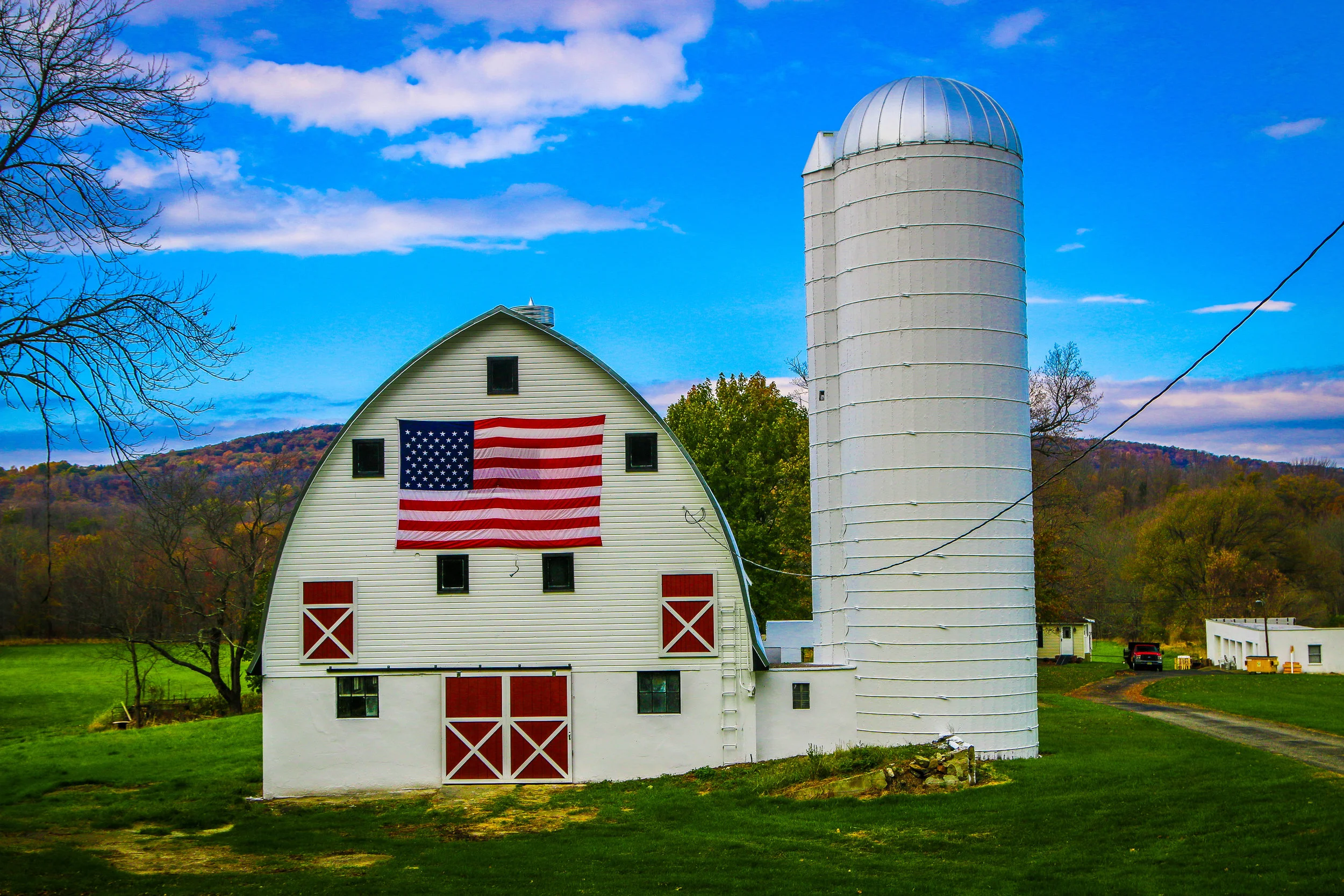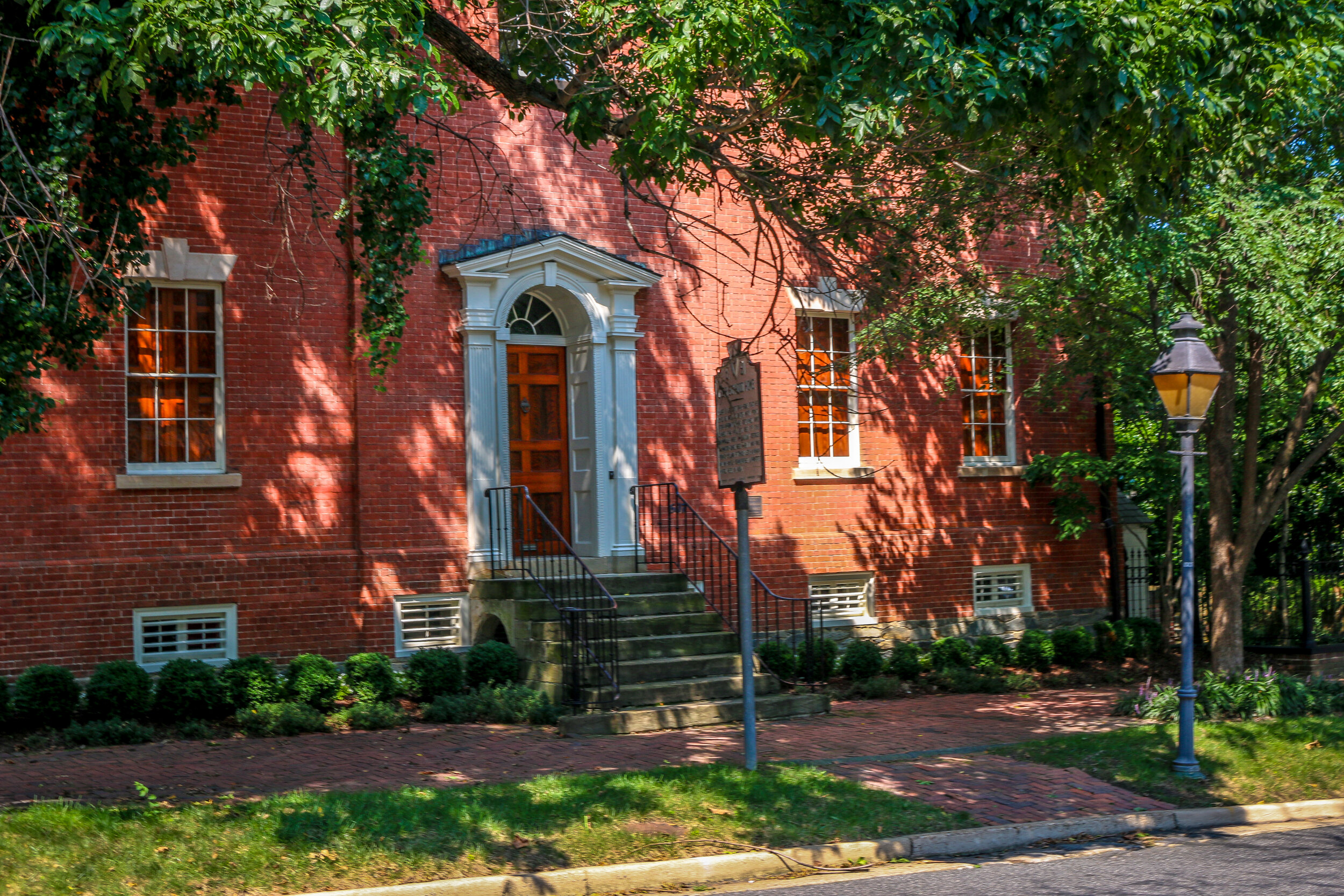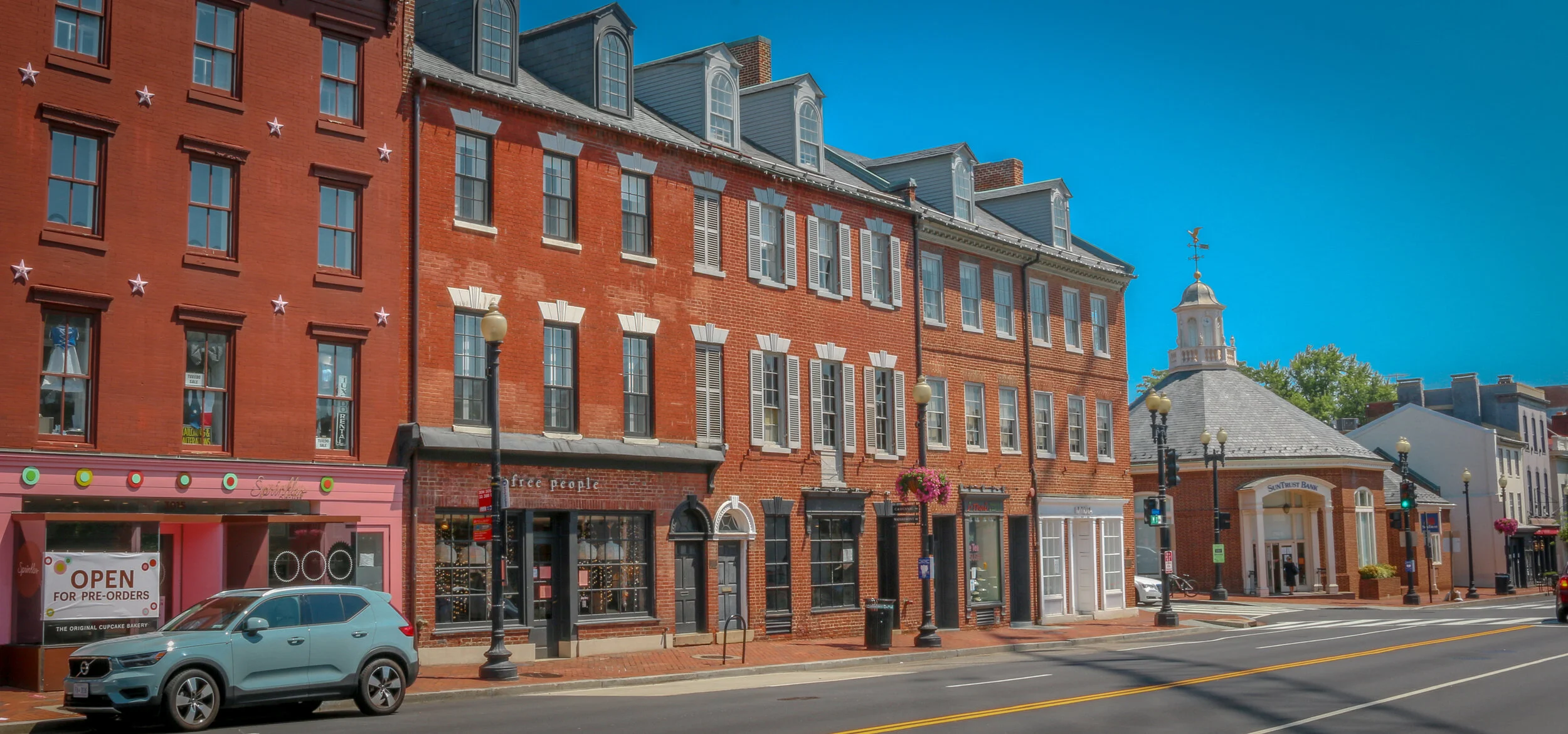The Potts-Fitzhugh house at 601-607 Oronoco Street in Alexandria is one of the most interesting houses still standing in the area. Known most famously as the Boyhood Home of Robert E. Lee, the house’s history goes much deeper. The house was built in 1795 in what was then the Alexandria section of Washington D.C. for John Potts. Potts was the secretary of the Potomac Canal Company, which was attempting to link the Potomac and Ohio Rivers with a canal around Great Falls. Potts was an old friend of George Washington who visited the house often and sometimes even spent the night during the year Potts resided in the house.
Potts lived in the Oronoco Street house for only about a year, and then sold it to William Fitzhugh, a wealthy Virginia tobacco planter and racehorse breeder who was looking for a city home. Fitshugh owned beautiful Chatham Manor in Fredericksburg which was right down the road from Ferry Farm, the boyhood home of George Washington. The two had served together in the Virginia House of Burgesses before the Revolution, and remained friends. In fact, Washington dined with Fitzhugh at this house on Oronoco Street just one month before he died, on his last visit to Alexandria. Fitzhugh was married to Ann Randolph and the couple had three children. One of their children, Mary Lee Fitzhugh, would grow up to marry George Washington Parke Custis, a grandchild of Martha Washington from her first marriage. The wedding took place in the parlor on Oronoco Street. George and Mary Lee had one daughter, Mary Anne Randolph Custis, who would grow up to marry Robert E. Lee in 1831, two years after he graduated from West Point. During the Civil War, the Lees would take refuge on the Fitzhughs’ country estate, Ravensworth, which they built after selling Chatham. When William Fitzhugh died in 1809, his city home on Oronoco Street passed to his son, also named William, who would rent it to the house’s most famous occupants: Henry “Light Horse Harry” Lee and his family which included then five-year-old Robert E. Lee.
Robert E. Lee was born in Stratford, Virginia in 1807, but he moved with his family to Washington D.C. in 1810, when he was just 3 years old, and lived at 611 Cameron Street in the Alexandria section. In 1812, they moved to this house on Oronoco Street where they lived for the next four years. The Lees would move to 407 N. Washington St. in 1816 but returned to the house on Oronoco Street in 1820. On October 14th, 1824, the Marquis de Lafayette was in Washington and wanted to visit his old Revolutionary War friend “Light Horse Harry” Lee’s widow and children,so he stopped by their home on Oronoco Street. Lafayette met 17 year-old Robert and no doubt told him of his father’s heroism in the Revolution. Robert lived on Oronoco St. until he departed for West Point in 1825 on the recommendation of William Fitzhugh the younger. When Robert left, his mother and two sisters moved across the river to Georgetown, but the house on Oronoco Street would be inhabited by other members of the Lee family for the next 62 years until it was sold to the Burson family in 1887. During the Lee family’s tenure there, Alexandria was retroceded to Virginia. One can only speculate on the fate of Robert E. Lee and the nation had his boyhood home remained a part of Washington D.C…
This post shares photos and a brief history of the Thomas Law House in Southwest Washington D.C.
The Thomas Law House was built between 1794 and 1796. It was designed by architect William Lovering who is credited with the design of several other properties which will be featured later in this series including The Octagon House, Wheat Row and the Duncannon-Cranch House. Thomas Law, formerly of the British East India Company, had recently immigrated to the United States with two of his three illegitimate sons born from his Indian mistress. He met and married Elizabeth Parke Custis, who was twenty years his junior, in 1796 and the couple moved into this newly built home which was then dubbed “Honeymoon House”. Elizabeth Parke Custis was the eldest granddaughter of Martha Washington from her first marriage. Elizabeth’s brother was George Washington Parke Custis, the builder of Arlington House (the Custis-Lee Mansion) and the father of Mary Anne Randolph Custis who would marry Robert E. Lee. Thomas and Elizabeth would live in this beautiful Federal Style home for only about five months before moving to a new home which was then under construction. They would divorce in 1811.
From 1814-1827, this house was occupied by Richard Bland Lee, brother of Henry “Lighthorse Harry” Lee and uncle of Robert E. Lee. Richard was the second cousin of Thomas Sim Lee, whose winter house in Georgetown was featured earlier in this series. Richard had served as a U.S. Representative from Virginia in the very first session of congress and had helped negotiate the Compromise of 1890 which established the Capital City of Washington D.C. He served three terms in congress and then returned to his family’s tobacco plantation – Sully – in Chantilly, Virginia. Financial hardships in the family eventually forced the sale of Sully after which Richard and his wife moved to the Thomas Law House. Richard would serve under President James Madison as a commissioner charged with helping rebuild the city after the War of 1812 and would later be appointed as a judge by James Monroe. He lived in this home until his death in 1827.
This post shares photos and a brief history of the Thomas Sim Lee Corner in Georgetown in Washington D.C.
At the end of the block where the Old Stone House has stood since 1765, you can find the historic winter home of Thomas Sim Lee, an associate of George Washington who had served as a colonel during the Revolution. He went on to become the 2nd and 7th Governor of the state of Maryland. During his first term, Lee consulted with then lieutenant colonel Uriah Forrest who would later live down M Street from Lee in what’s now known as the Forrest-Marbury House (read about it HERE). After his second gubernatorial term ended in 1794, Lee moved to Georgetown and built this lovely corner house. In July of that year, Washington offered Lee a role on the Board of Commissioners which was overseeing construction of the new capital city, but Lee turned him down. After the death of his wife, Mary, in 1805, Lee moved permanently to his country estate in Frederick County.
The Thomas Sim Lee house would go through several owners over the next century and a half, but it eventually fell into a dilapidated state and was slated for demolition in 1950. This was right about the time that congress had authorized the purchase of the Old Stone House a block away, and a Georgetown resident named Dorothea de Schweinitz quickly mobilized her friends to save the Lee Corner from the wrecking ball. The Architectural Review Board of the Commission of Fine Arts reviewed the property and recommended against demolition. Miss de Shweinitz organized her neighbors and helped found Historic Georgetown Inc. which sold shares at a dollar apiece and purchased the property outright. They then began renovations of the building and found renters to occupy it. The simultaneous preservation of the Old Stone House and the Thomas Sim Lee Corner was the beginning of a movement to save historic Georgetown, a move I’m sure area residents are grateful for today…
I took these photos last week in the midst of the Confederate statue removal process in the old Confederate Capital of Richmond. It was a unique time to visit because some of the statues had already been removed, one of JEB Stuart was in the process of being removed and the two central ones to Robert E. Lee and Jefferson Davis still stood, although both have been slated for removal.
In taking these photos I wanted to capture the spirit of the protests which ultimately have led to the conversation over the removal of these statues, so I have included some close-up shots of the graffiti. Some of the graffiti is targeted towards police brutality while some supports the Black Lives Matter movement.
I am of the opinion that these statues cannot continue to stand in these central places in our nation’s cities. While there are aspects of all of these men which I admire and respect, the cause for which they fought was ultimately the continuation of slavery in perpetuity. There are places for these statues as I believe all art tells a story, but the story currently being told isn’t a complete one and needs to be adjusted with our current understanding of history. These statues coming down isn’t erasing history, it is history.
Hello everyone, well another week has rolled by us and it has not been a bad one here on the homefront in Washington D.C. One of my friends got engaged this week, another announced a pregnancy and still another welcomed a new grandchild into the world so those were some real positive boosts. I’ve been getting some good walks in around the neighborhood despite mid-summer temperatures and high humidity levels and have been enjoying the podcast Civil War Talk Radio as I walk. It’s been great to hear some expert historians discuss some very specific issues of the war. I’ve been trying to keep myself hydrated which as silly as it sounds has been really helping me feel better. I’m usually really good at hydrating, but seem to have let it slip amidst all of the chaos of late. I’ve also been trying to keep a little further from the news and have been picking my guitar more and reading some less heavy material. I’ve started rereading Steinbeck’s Travels With Charley, one of my favorite American travel books of all time, as I start to gear up to get back to writing my own book. I had charged ahead with it when I first got home, but realized I needed to focus more and plan it out a little better to keep the story moving and make it more readable and interesting. That’s tough because every day I was out on the road was a new adventure and had an impact on the journey, but the book can’t be a thousand pages long, so I will need to map it out a little better. I hope to start putting pen to paper a little later this week.
Also this week I decided to pick up a violin seriously for the first time in 30 years. When I was in Junior High School, I used to play violin and I was actually fairly decent at reading music. Unfortunately, I was not very interested in it because I didn’t know any of the songs my teacher wanted me to play. While she said I played them well, how could I know? I have always likened it to cooking a recipe for something you’ve never eaten before, you may think it tastes just fine, but if you don’t know how it’s supposed to taste, you’d never know. Anyways, in the intervening years, I’ve seen the violin played in very different styles of music in my travels around the country and around the world (although in these styles it’s often referred to as a “fiddle”, it’s the exact same instrument). I’ve seen lots of live bands playing traditional Irish music or country, mountain and folk music and I really enjoy it. About 2 years ago when I was in Nashville I went ahead and bought one thinking I’d give it a shot on the road – it’s a relatively small instrument and I found a place for it in my van. I had romantic images in my head of sitting in the back of my van at night and playing beautiful music before bed. Sadly, I realized that the violin actually takes some space to play with the bow going up and down and my van was too tight to really make it happen. And so it just sat there. I found the space for a guitar instead which takes more room to carry but less room to play. This week I pulled out that violin though and took it for a spin. I was pleasantly surprised that with a little refresher from a book and the internet I could remember how to read music and with some sheet music of songs I actually know I could actually play them that first night (not well, but recognizable). I was impressed and really enjoyed it. Sadly, when I pulled it out last night the bridge fell off and I spent an hour trying to restring it and it was generally a big frustrating mess. But I hope to get it fixed and continue playing with it. This was another big plus this week.
The news has, as always seems to be the case recently, been a big minus. Covid cases continue to grow at a rapid rate in the U.S. and people continue to ignore it. Although we have only about 4% of the world’s population, I believe we now have over a quarter of the world’s cases…






